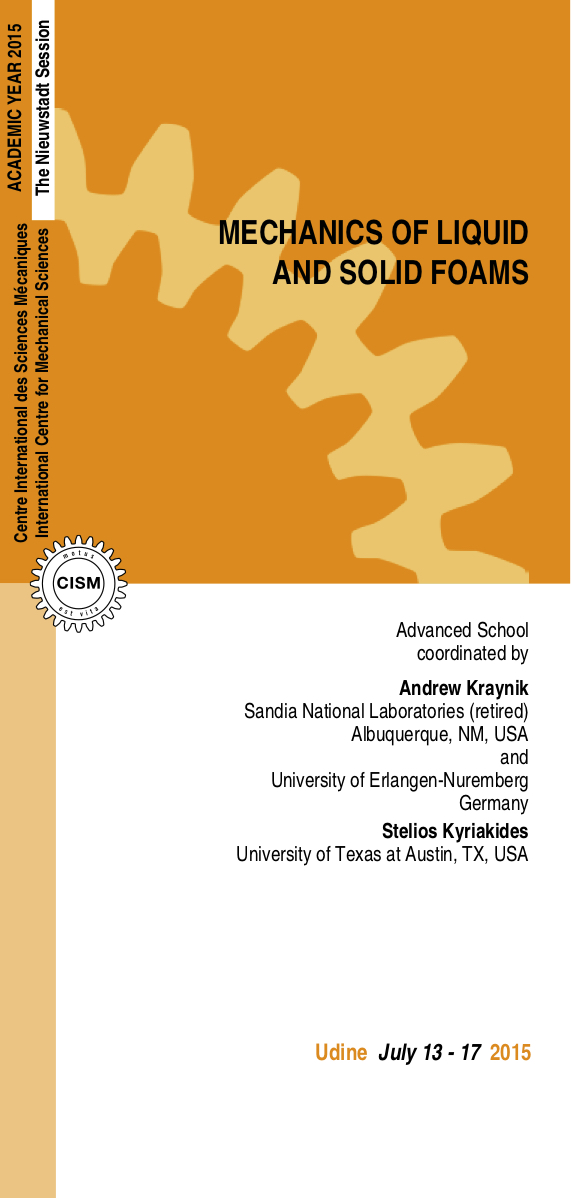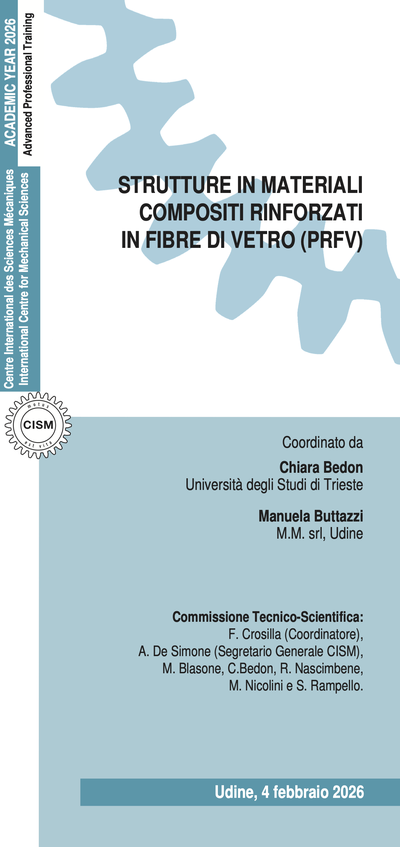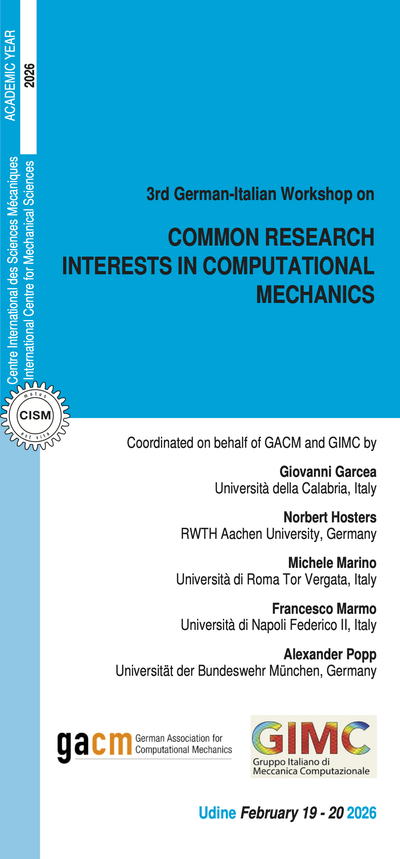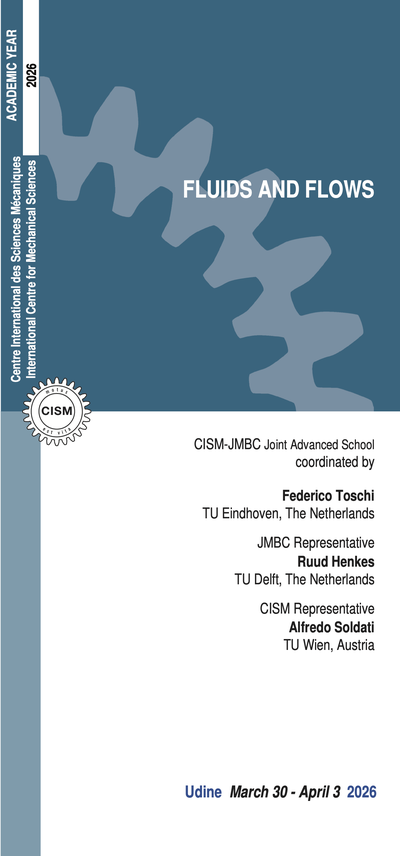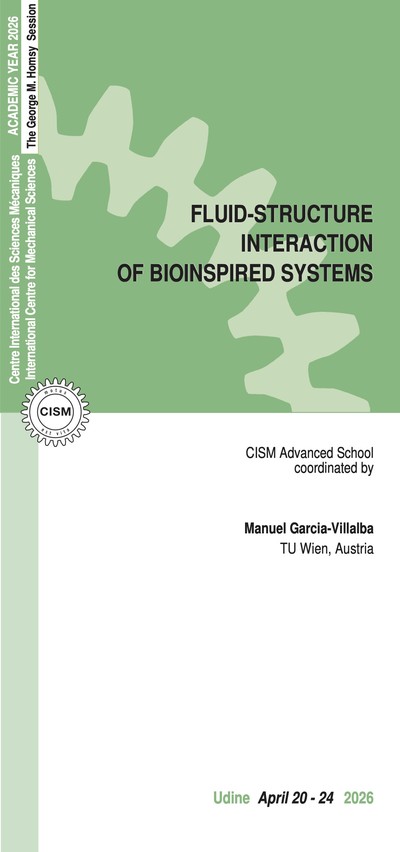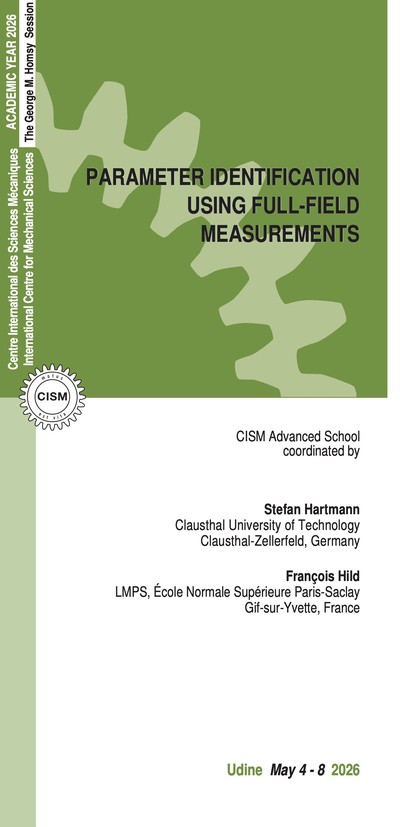This course will focus on the relationships between the cellular microstructure and the nonlinear mechanical behavior of liquid and solid foams, and foam-like biological and synthetic materials. Consequently, this survey of foam mechanics will explore numerous topics in applied mechanics ranging from traditional fluid mechanics to solid mechanics. Theoretical analysis, numerical simulations, and experiments will be used to unravel the complex relationships between cell-level structure, local deformation mechanisms, and macroscopic mechanical behavior. The cells in liquid foams, such as soap froth, are polyhedral gas bubbles separated by thin liquid films that are stabilized against rupture by surfactants. Many commercially important cellular solids, such as polymer, food and metal foams, are formed when liquid foams solidify into structures that can have open or closed cells. The growth of spherical gas bubbles in a liquid and their evolution to form the polyhedral cells in low-density foam are key features of foam manufacturing processes, and illustrate the interplay between the mechanics of liquid and solid foams. The cell-level architecture of low-density foams can be viewed as polyhedra that fill space, forming networks of surfaces or edges, that can be random or regular. Similar networks are characteristic of biological materials, such as trabecular bone, the cytoskeleton, and cells in animal tissues such as the eye of the Drosophila fruit fly. Liquid foams are used in firefighting, mineral ore separation, drilling fluids and mobility control in the petroleum industry, and a wide range of consumer products, foods and beverages. Natural and synthetic cellular solids are lightweight materials with unique and advantageous combinations of properties involving stiffness- and strength-to-weight ratio, energy absorption, thermal insulation and acoustics, all of which can be tuned by controlling density and cell morphology. Despite significant progress in understanding foam rheology and mechanics over the last few decades, the complex nonlinear phenomena that occur at all length scales remain poorly understood. Whether the structure is two-dimensional and ordered or three-dimensional and highly disordered the fluid mechanics and solid mechanics is very challenging when taking a micromechanical point of view. For solid foams connecting the microstructure and the mechanical properties of the base material to the macroscopic behavior of the material remains a challenge. Models involving idealized ordered microstructures, such as the Kelvin foam, and realistic random microstructures with different cell sizes will be presented, and the strengths and weaknesses in predicting all aspects of mechanical behavior will be discussed. Taken as a whole, the participants will be presented with the state of the art in the mechanics of liquid and solid foams and will be exposed to many open questions. The broad course topics are: cell-level foam structure (including a tutorial Surface Evolver simulations), rheology and aging of liquid foam, and the mechanics of solid foams and biological cellular materials. Both liquid and solid foams exhibit linear elasticity, yielding and plasticity, and the onset and propagation of instabilities. The target audience for this course is PhD students and postdocs in engineering, physics, and materials science, as well as young and senior researchers in academia and industry.
Lorna J. Gibson and Michael F. Ashby, 1997, Cellular Solids: Structure and Properties, 2nd ed., Cambridge University Press, Cambridge. Denis Weaire and Stefan Hutzler, 1999, The Physics of Foams, Oxford University Press, Oxford. Cohen-Addad, S., Höhler, R., Pitois, O., 2013, Flow in foams and flowing foams, Ann. Rev. Fluid Mech. 45, 241-267. Gaitanaros, S., Kyriakides, S., Kraynik, A.M., 2012, On the crushing response of random open-cell foams, Int. J. Solids Structures, 49, 2733–2743. Gaitanaros, S., Kyriakides, S., 2014, Dynamic crushing of aluminum foams: Part II – Analysis, Int. J. Solids Structures, 51,1646–1661. Hilgenfeldt, S., Kraynik, A.M., Reinelt, D.A., Sullivan, J. M., 2004, The structure of foam cells: isotropic Plateau polyhedra, Europhysics Lett. 67, 484-490. Koehler, S.A., Hilgenfeldt, S., Stone, H.A., 2000, A generalized view of foam drainage: experiment and theory, Langmuir, 16:15, 6327-6341. Kraynik, A.M., Reinelt, D.A., van Swol, F., 2003, Structure of random monodisperse foam, Phys. Rev. E, 67, 031403.
Stavros Gaitanaros (Massachusetts Institute of Technology, Cambridge, MA, USA)
2 lectures on: Dynamic crushing and shock development in random open-cell foams; quasi-static vs. dynamic impact; and “subsonic” and “supersonic” behavior.Sascha Hilgenfeldt (University of Illinois, Urbana-Champaign, IL, USA)
6 lectures on: Foam drainage, rupture and fracture in liquid foams, continuum thermodynamics approach to the mechanics of cellular solids, from foams to tissues: finding mechanical equilibria, Surface Evolver tutorial with student exercises.Reinhard Höhler (Université Pierre & Marie Curie (Paris 6), France)
8 lectures on: Liquid foam rheology, viscous dissipation, plastic flow, osmotic and capillary pressure, jamming transition, foam mechanics and glassy dynamics, simplified foam mechanics models on the bubble scale, experimental techniques for probing foam structure and rheology, acoustic wave propagation in solid foams.Andrew Kraynik (Sandia National Laboratories, Albuquerque, NM, USA and University of Erlangen-Nuremberg, Germany)
8 lectures on: Overview of foam structure, rheology and mechanics in two and three dimensions, idealized (ordered) and realistic (random) foam structure, foam micromechanics, soap froth rheology, viscous effects, wet foam structure, linear elasticity of solid foams.Stelios Kyriakides (University of Texas at Austin, TX, USA)
8 lectures on: Experimental, analytical and numerical results on the mechanics of 2D honeycombs and 3D foams (elastic properties, large-deformation compression, instability: onset, localization and spreading, densification, elastic vs. plastic materials), dynamic crushing.Patrick Onck (University of Groningen, The Netherlands)
4 lectures on: Micromechanics of 2D cellular materials, micromechanics of trabecular bone, fracture of metal foams, mechanics of cross-linked fiber networks.